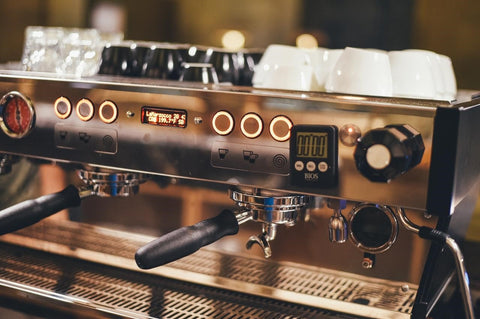I get this question all the time. I remember when I first heard about the Aeropress and how it can brew true, balanced espresso. Even though I was new to specialty coffee, the rumor of this perfect manual espresso maker sounded too good to be true.
Why would anyone buy a giant, multi-thousand dollar espresso machine if they could get the Aeropress for less than $30? I had to find out.
After lots of research and consulting baristas, I discovered the truth behind the rumors. The answer is shocking, disappointing, and exciting all at the same time. I’ll just say it.
Aeropress espresso is not true espresso.
Let me show you why. And what you can do about it.
The Definition Of Espresso
After three years of being a barista at a quality-first coffee shop, I can confidently say that espresso is a beautiful, complex, and frustrating beverage to create. It’s thick, it’s concentrated, it’s bursting with flavor, and it’s extremely easy to mess up.
Espresso shots are so concentrated that you can taste 1 oz of espresso through 11 oz of milk. That’s how it’s designed to be: intense.
Let’s look at an official definition.
According to the Specialty Coffee Association of America, espresso is…
“... a 25-35ml (.85-1.2 ounce) beverage prepared from 7-9 grams (14-18 grams for a double) of coffee through which clean water of 195 °-205 °F (92 °-95°C) has been forced at 9-10 atmospheres of pressure, and where the grind of the coffee is such that the brew time is 20-30 seconds.”
Now, this definition is very specific. Actually, It’s so specific that I don’t like to use it. Quite a few coffee shops pull legitimate espresso shots that are outside of this narrow range - and they’re just as or more delicious than shots that are created using this definition.
Here’s my more practical definition.
A concentrated shot of coffee created by forcing hot water through super-fine coffee grounds at 7-10 atmospheres of pressure (through an espresso machine).
Notice the key similarities in both of these definitions:
- 7-10 bars of pressure (a whole lot)
- Super fine coffee grounds (like… powdered sugar)
- Extremely concentrated beverage (1-2 oz of liquid)
Whether you’re in a shop in France or in Los Angeles, espresso is going to match these less strict criteria. It’s going to be rich and concentrated. It’s going to have a thick layer of crema, which is widely considered a sort of test for true espresso.
None of this means espresso pulled with that criteria will taste good. It simply defines what espresso is and is not - taste aside.
Read: What Makes Specialty Coffee Special?
How Espresso Machines Work
Espresso machines are feats of engineering. A water boiler (or three) deep inside keeps the water temperature at just the right temperature all day long. The group heads (where the portafilters attach to the machine) are filled with this water and also maintain a steady temperature.
These machines have a pump or two that can generate 7 to 10 bars of pressure on command. It’s this pressure that is mainly responsible for the crema.
Espresso machines are powerful devices with backbones of science and engineering.
Why The Aeropress Falls Short On Espresso
The Aeropress is also a feat of design and engineering but in a different set of ways.
It’s small, versatile, brews stellar coffee, and even uses pressure to brew (like espresso machines). However, the difference in the amount of pressure is dramatic.
Read: The Ultimate Guide To Espresso
Take a look at these numbers.
9 bars of pressure is used to create true espresso from an espresso machine. In regular people’s terms, that’s 640 pounds of pressure.
The Aeropress, according to the official website, can generate .35 to .75 bars of pressure, which is only 25-50 pounds of pressure.
As you can see, this is a huge difference. It’s simply not feasible for a person to create 640 pounds of pressure with an Aeropress. Even if you could, the brewer isn’t designed to withstand that kind of pressure.

Sure, you can get a small layer of foam when you use fine grounds and a lot of pressure in the Aeropress, but it’s nothing compared to the fine crema of espresso.
To add to the problem, forcing water through super fine grounds by hand using the Aeropress is nearly impossible. The Aeropress is enough work already with a medium grind. Going as fine as you would with an espresso machine would just be a nightmare.
In short, no. The Aeropress cannot make true espresso. It’s not a true manual espresso maker.
Read: The Ultimate Guide To Aeropress Coffee
But Wait - Don’t Give Up Hope
Despite falling short in some significant ways, the Aeropress is actually one of the easiest ways to get espresso-like coffee at home without having to spend hundreds of dollars.
You can make Aeropress espresso (not real espresso) by using finely ground coffee, a small amount of hot water, and a very rapid plunge. It’s not exactly there, but it’s close.
It’s not as concentrated as true espresso, nor is it as intense or crema-topped. But, if you do it right, it can be balanced and tasty. You can even use it to make faux-espresso drinks at home.
Pour over cones and french presses cannot come close to making coffee that’s concentrated like this and still balanced. But the Aeropress has the element of pressure, which gives it a way.
Here’s the recipe for Aeropress espresso.
I strongly suggest using a metal filter to make Aeropress espresso. Paper filters take out too much of the oils and micro-grounds that contribute towards to the espresso-like qualities. You want to keep those, and a reliable mesh filter can do that for you.
Happy brewing!


